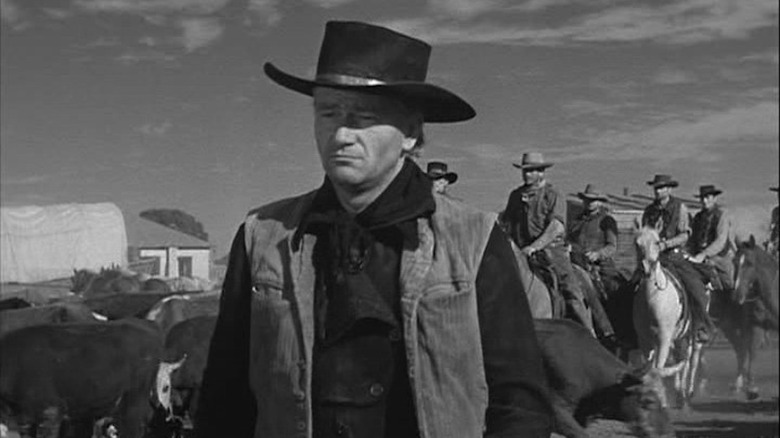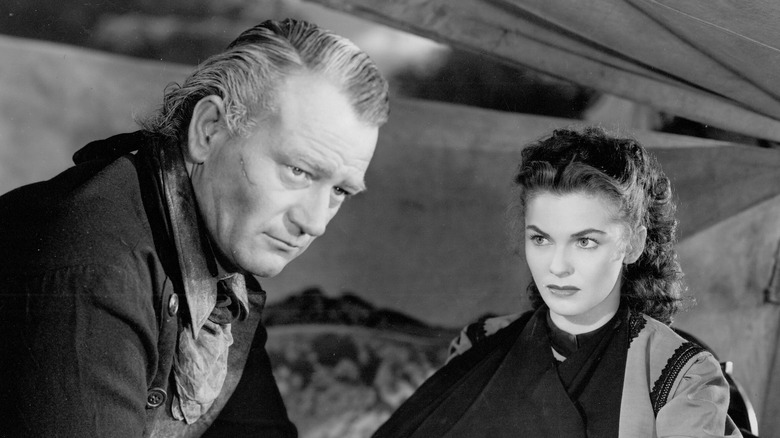John Wayne And Howard Hawks Didn't See Eye To Eye Over How To Approach His Red River Role
John Wayne had cemented his status as one of the biggest movie stars in Hollywood when he encountered his first major challenges as an actor in Howard Hawks' "Red River." While playing a hard-case cattle driver like Thomas Dunson was right in the Duke's macho wheelhouse, the character's age and Ahab-like obsessiveness called for him to step outside of his swaggering, heroic persona. He had to look old and be not just ornery, but downright unlikeable.
It's the kind of role Wayne would only take on as a collaboration with a director he respected as more than an overseer. Hawks was a versatile master of the visual medium. He could do screwball comedy, gangster flicks, war movies, film noir, and Westerns, bringing a rare intelligence to each without turning them into joyless, awards-courting prestige pictures. The biggest stars of the day (Gary Cooper, Cary Grant, and Humphrey Bogart) were eager to work with Hawks, so it was a feather in the Duke's cap to team with him on "Red River."
But while Wayne was willing to be directed, there were aspects of his performance where he disagreed with Hawks, particularly when it came to conveying Dunson's advancing age.
John Wayne stood tall or not at all
"Red River" opens with John Wayne adopting Matt Garth, the sole survivor of a raid by indigenous people on a wagon train that claimed the life of Thomas Dunson's fiancee. After Dunson establishes his cattle ranch on the Red River in Texas, the film jumps forward 14 years. Matt (Montgomery Clift) is becoming a capable rancher in his own right, while Dunson, getting on in years, is desperate to drive his herd to Missouri, where a big sale would offset the losses he's incurred during the post-Civil War Depression.
Wayne had just turned 40 when he made "Red River," and was still a tad too spry for Howard Hawks' liking. So he asked the Duke's costar, a 13-years-older Walter Brennan, to give him a tutorial in old-man behavior. This didn't go over well. According to Maurice Zolotow's "John Wayne, Shooting Star," Wayne said:
"Brennan showed me his idea of an old man walkin' and talkin'. His idea was kinda shufflin' and totterin'. And mumblin' I was supposed to be tough and hard and walk like that? Hell, I was thinkin' about those old cattle guys I knew when I was a kid around Lancaster and there wasn't one of them who didn't stand tall. I played Tom Dunson my own way, standin' tall."
The Duke didn't like to cringe
John Wayne's other bone of contention with Howard Hawks involved a request to have Thomas Dunson wince when Matt Garth rebels against his father and, with the full support of the other men on the drive, informs him that they'll be taking the cattle to Abilene, Kansas. Dunson, who's been quick to shoot deserting cowboys, is grievously wounded by Matt's betrayal. This is the young man he rescued and raised as his own.
A small wince would hardly be out of order for anyone in this situation, but Wayne's Dunson was, again, a man who stood tall no matter the challenge. So he refused Hawks' direction. Per Maurice Zolotow, Wayne said, "Howard, a guy can kill, he can be mean and vicious — and he could still hold an audience. But let him show a yellow streak and he will lose them. I'm not about to cringe. I agree with the audience."
Cringe or no cringe, Dunson wound up being one of Wayne's most fascinatingly obstinate characters. He finally mends fences with Matt (after some good ol' fashioned fisticuffs), but we're far more sympathetic to the young man than the guy whose stubborn determination to drive to Missouri likely would've gotten everyone killed. But Wayne was probably right. His actions at the end (which include adding an "M" to the ranch brand) speak much louder than a wince.


